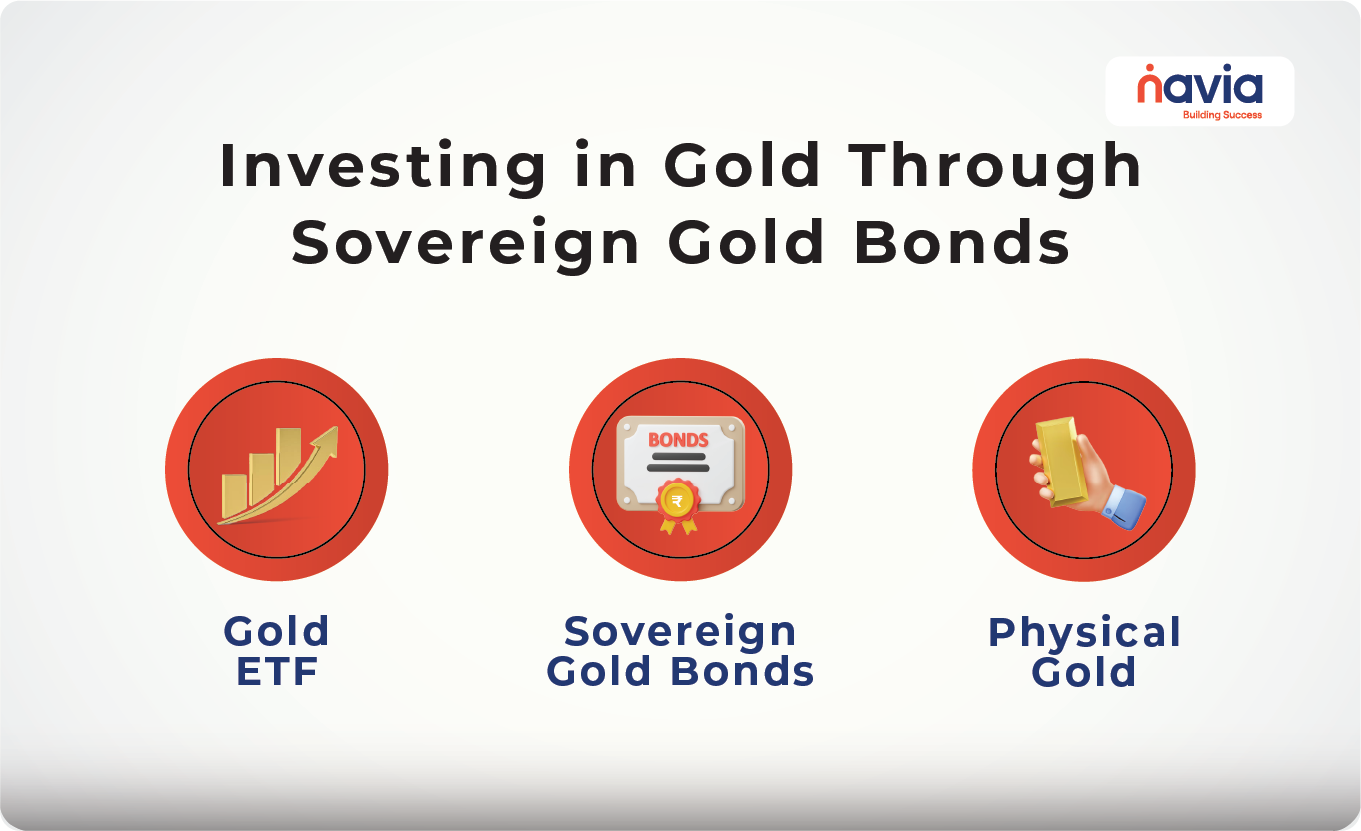Investing in Gold Through Sovereign Gold Bonds

Introduction: The Gold Investment Dilemma in India
Gold has been a cornerstone of Indian wealth for centuries, revered for its beauty, rarity, and store of value. It continues to play a crucial role in the investment portfolios of Indian families, and it’s no surprise that investors are drawn to the idea of buying gold as part of their strategy for wealth preservation and growth.
However, there are three primary ways to invest in gold in India:
1. Gold ETFs (Exchange-Traded Funds)
2. Sovereign Gold Bonds (SGBs)
3. Physical Gold
While all three options have their merits, Sovereign Gold Bonds (SGBs) offer a superior blend of security, returns, and tax efficiency. In this article, we’ll explore why investing in gold through SGBs should be your preferred choice, and compare it with other options such as Gold ETFs and Physical Gold.
What Are Sovereign Gold Bonds (SGBs)?
Sovereign Gold Bonds are government-backed securities that offer a way to invest in gold without the need to physically buy or store the metal. Launched by the Indian government in 2015, SGBs allow investors to buy gold in a paper or electronic form, with the value of the bond linked to the price of gold. These bonds come with additional perks, such as annual interest payments and tax benefits, making them an attractive option for Indian investors.
Key Features of Sovereign Gold Bonds
| Feature | Details |
| Issuer | Reserve Bank of India (RBI), on behalf of the Government of India |
| Denomination | 1 gram of gold per unit |
| Interest Rate | 2.5% per annum, paid semi-annually |
| Tenure | 8 years, with an exit option after the 5th year |
| Taxation | Tax on capital gains (long-term or short-term) as per Income Tax Act. Interest is taxable. |
| Liquidity | Tradable on the stock exchange |
| No Storage Risk | No need to physically store the gold |
| Price | Linked to the price of gold (based on the market price of 999 purity gold) |
| Minimum Investment | 1 gram of gold |
Benefits of Investing in Sovereign Gold Bonds
1. Government Backing – A Secure Investment
SGBs are backed by the Indian government, making them a secure and risk-free investment. Unlike physical gold, which can be lost or stolen, or Gold ETFs, which are subject to market volatility and management fees, SGBs offer sovereign guarantee on gold-backed securities.
2. Interest Payments: A Passive Income Stream
One of the key advantages of investing in SGBs over Gold ETFs or Physical Gold is the 2.5% annual interest paid on the bond on its issue price. This interest is credited to your bank account semi-annually, providing you with a regular passive income. In contrast, Gold ETFs and Physical Gold do not provide any interest payments—they only offer capital appreciation from changes in the price of gold.
| Investment Type | Interest | Capital Appreciation |
| Sovereign Gold Bonds | 2.5% per annum paid semi annually on issue price | Based on gold price |
| Gold ETFs | None | Based on gold price |
| Physical Gold | None | Based on gold price |
This feature makes SGBs an attractive long-term investment that combines capital appreciation with income generation, unlike Gold ETFs or Physical Gold, where income is solely based on price movements.
3. No Storage or Security Risk
One of the significant disadvantages of Physical Gold is the risk of storage and theft. When you buy physical gold, you are responsible for securely storing it, either at home or in a bank locker, both of which incur additional costs.
SGBs, however, are held electronically in your Demat account or in paper form, meaning there’s no need for physical storage. This eliminates storage fees and the risk of theft, offering a hassle-free gold investment experience.
In comparison, while Gold ETFs also have the advantage of being electronically held, they come with management fees and expenses that can diminish the return on your investment. For example, GOLDBEES ETF expense ratio is 0.82% annually. SGBs, on the other hand, have no management fees or storage charges.
4. Tax Benefits: Capital Gains Tax Exemption
Perhaps the most compelling reason to invest in SGBs is the tax exemption offered on capital gains if the bonds are held until maturity (8 years). The capital gains arising from the redemption of SGBs are exempt from tax.
On the other hand, Physical Gold and Gold ETFs are subject to capital gains tax:
🠖 Short-term capital gains tax is levied if the asset is sold within 3 years, and
🠖 Long-term capital gains tax applies if the holding period exceeds 3 years (except for SGBs, where the exemption applies for long-term holding).
Moreover, the interest earned from SGBs is taxable, but it is subject to the investor’s personal tax bracket. This makes SGBs particularly advantageous when considering both capital gains and tax efficiency in the long run.
| Investment Type | Tax on Capital Gains | Tax on Interest |
| Sovereign Gold Bonds | Exempt (if held till maturity) | Taxable as per income tax slab |
| Gold ETFs | Short-term (3 years) or long-term | Not Applicable (no interest) |
| Physical Gold | Short-term (3 years) or long-term | Not Applicable (no interest) |
5. Liquidity and Flexibility
SGBs offer flexibility and liquidity. While Physical Gold may be difficult to sell quickly, especially if you need cash in a hurry, SGBs can be sold or traded on the stock exchange. This means that you can liquidate your investment easily, and you are not locked into the bond for the entire 8-year term. Additionally, there are minimum transaction costs when selling SGBs on the exchange, unlike Physical Gold, which often involves mark-up prices and transaction fees.
Gold ETFs also offer liquidity since they are traded on stock exchanges, but unlike SGBs, they are subject to management expenses.
| Type of Investment | Minimum Investment Amount | Advantages |
| Sovereign Gold Bonds | 1 gram of gold | Accessible, No storage issues, Regular interest. No expense. |
| Gold ETFs | 0.01 gram of gold | Liquid, Traded on exchange, High Management fees |
| Physical Gold | 0.5 gram of gold | Tangible, Flexible, High storage costs |
6. Exposure to Market-Driven Gold Prices
SGBs, like Gold ETFs, are directly linked to the price of gold in the market. Unlike Physical Gold, whose pricing can vary based on dealers and other costs, SGBs and ETFs reflect the current market price of gold, ensuring that investors get true exposure to the gold market at any given time.

Comparing SGBs with Gold ETFs and Physical Gold
| Factor | Sovereign Gold Bonds (SGBs) | Gold ETFs | Physical Gold |
| Issuer | Government of India | Fund managers tracking gold prices | Dealers or retail stores |
| Liquidity | Tradable on stock exchanges | Highly liquid on stock exchanges | Difficult to sell quickly, involves transaction costs |
| Interest | 2.5% per annum on issue price | None | None |
| Taxation | Exempt from capital gains tax (on redemption) | Taxable capital gains | Taxable capital gains |
| Storage & Security | No storage risk, held electronically | No storage risk, held electronically. | Risk of theft, storage fees |
| Minimum Investment | 1 gram of gold | 0.01 gram of gold | 0.5 gram of gold |
| Charges | No Management fees, low trading charges | High Management fees, low trading charges | High Making charges, GST, question of Purity |
Conclusion: Why SGBs Are the Preferred Choice for Gold Investment?
Sovereign Gold Bonds (SGBs) offer a unique combination of benefits that make them the preferred choice for gold investment in India. The security of government backing, coupled with annual interest payments, tax exemptions, and no storage risk, makes them an attractive alternative to Gold ETFs and Physical Gold.
Moreover, their affordable minimum investment, flexibility in liquidity, and market-driven pricing further enhance their appeal. For investors seeking a safe, efficient, and profitable way to invest in gold, SGBs provide a clear advantage.
In conclusion, if you’re considering investing in gold in India, Sovereign Gold Bonds offer the best balance of returns, safety, and convenience, making them the most recommended option for modern investors.
Do You Find This Interesting?
Disclaimer: Investment in gold and related instruments carries risks. It’s advisable to consult with financial advisors and conduct due diligence before making investment decisions.






